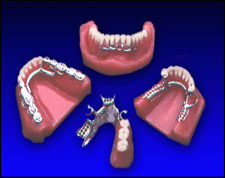المقالات
Upper Partial

An upper partial denture can be a good way to replace missing teeth. When you save your remaining teeth and have a partial denture, you'll chew better, look better, and have a healthier mouth. A typical upper partial denture is held in place by metal clasps that fit around the anchor teeth.
The process of making an upper partial denture involves a series of appointments. Though the process varies in each individual case, it usually involves minor shaping of the teeth followed by impressions. Models are made from the impressions and it's on the models that the partial framework and final partial denture are fabricated in a dental laboratory. After several try-ins and adjustments, the partial denture is seated.
Metal clasps for retention A partial denture prevents several problems. By filling in spaces, it prevents neighboring teeth from shifting. If missing teeth aren't replaced, it can set off a chain reaction that can result in cavities and periodontal disease. It also helps balance your bite. This means you'll chew better and have a healthier jaw joint. Partials also add support to your cheeks and lips. This support is necessary to speak clearly and look your best.
Some temporary problems are a normal part of adjusting to a new upper partial denture. At first, it may tip when you chew. You may notice increased salivary flow. It may seem bulky. You may gag a little. Your tongue will feel crowded, and you may have difficulty speaking. But don't worry; as you get used to your new partial these problems will go away. With time and practice, you'll make the adjustment and be eating with confidence.
